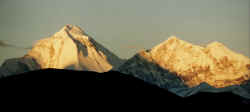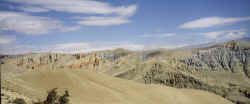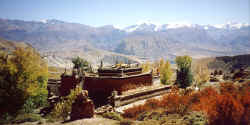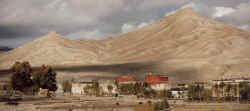MyHimalayasimpressions from |
|
|||||||

Upper Mustang: Introduction
Mustang - Kingdom in the Himalayas
Our fascination for the unknown and the ability to
explore the undiscovered have given us access to almost
every corner& of the world.
 One
of the few regions which could escape foreigners was Mustang, a Buddhist
kingdom in the Himalayas. Only a handful of Westerners had visited the
area in western Nepal before it was opened to tourism in 1992. They brought back reports of a
culturally highly developed, thriving medieval society and a landscape
almost beyond description.
One
of the few regions which could escape foreigners was Mustang, a Buddhist
kingdom in the Himalayas. Only a handful of Westerners had visited the
area in western Nepal before it was opened to tourism in 1992. They brought back reports of a
culturally highly developed, thriving medieval society and a landscape
almost beyond description.
 It
lies north of the two 8'000 meter peaks Annapurna and Dhaulagiri. The arid place with snow-capped mountains and barren hills
reaches deep inside the vast Tibetan plateau. Cold winds sweep through
narrow canyons and over plains. Erosion has left its marks in
bizarre rock formations.
It
lies north of the two 8'000 meter peaks Annapurna and Dhaulagiri. The arid place with snow-capped mountains and barren hills
reaches deep inside the vast Tibetan plateau. Cold winds sweep through
narrow canyons and over plains. Erosion has left its marks in
bizarre rock formations.
Yet humans have lived in this hostile environment for centuries. They have built their settlements along rivers and creeks, the villages of whitewashed houses appear like oases in a huge desert. People work as farmers on their fields, sowing and harvesting barley and potatoes, and driving cattle to relatively fertile meadows.
 High
up in vertical cliffs are inaccessible caves where people dwelled two
thousand years ago. Much later the region came under the influence of the
Tibetan Yarlung dynasty. In the 15th century the independent kingdom of Lo
was founded by Amepal, whose invitation of the famous Buddhist scholar
Ngorchen Künga Zangpo led to a cultural zenith never to be reached again
in the following centuries.
High
up in vertical cliffs are inaccessible caves where people dwelled two
thousand years ago. Much later the region came under the influence of the
Tibetan Yarlung dynasty. In the 15th century the independent kingdom of Lo
was founded by Amepal, whose invitation of the famous Buddhist scholar
Ngorchen Künga Zangpo led to a cultural zenith never to be reached again
in the following centuries.
It was probably thanks to its remoteness that even in later times of conquest Mustang was granted large autonomy. The destruction of their culture and religion could be averted but the Hindu culture and tourism are definitely a threat these days.
 Only
in 1950 was it officially declared part of Nepal. The years following the
Chinese invasion of Tibet proved to be the most difficult ones in Mustang’s
history. Large numbers of Tibetan freedom fighters set up their camps and
attacked the nearby Chinese troops, putting Nepal in a delicate situation.
In the 1970 the Dalai Lama asked the guerillas to stop their fighting, the
Nepalese government arrested and sentenced some of the leaders.
Only
in 1950 was it officially declared part of Nepal. The years following the
Chinese invasion of Tibet proved to be the most difficult ones in Mustang’s
history. Large numbers of Tibetan freedom fighters set up their camps and
attacked the nearby Chinese troops, putting Nepal in a delicate situation.
In the 1970 the Dalai Lama asked the guerillas to stop their fighting, the
Nepalese government arrested and sentenced some of the leaders.
It takes some effort to discover the scenic and cultural beauties and mysteries of such an area. Our plan is to follow the Kali Gandaki from Jomosom northwards for two days, then taking the west route to the capital Lo Manthang and from there back to Jomosom over the holy site Muktinath.
More than two weeks in a different world lie ahead of us...
- Part 1: Pokhara - Kagbeni
- Part 2: Kagbeni - Gemi
- Part 3: Gemi - Lo Manthang
- Part 4: Lo Manthang - Lo Gekar - Tetang
- Part 5: Tetang - Muktinath - Pokhara